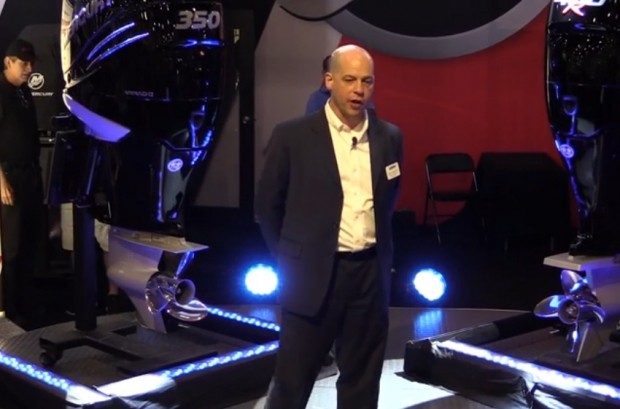Watch the video of John Pfeifer, President of Mercury Marine, introduced four new engines at the Miami International Boat Show.
John Pfeifer, President of Mercury Marine, introduced four new engines at the Miami International Boat Show in Miami Beach, Florida – the Verado® 350hp outboard, Mercury Racing Verado 400R outboard, Mercury Racing QC4v 1550 sterndrive and Mercury 4.5-liter 200hp sterndrive. Watch the video of the unveiling here.
Verado 350
The Verado 350 is the most powerful engine in Mercury’s class-leading Verado family of four- and six-cylinder supercharged FourStroke outboards, ranging from 175hp to 350hp. Built on Mercury’s proven supercharged inline six-cylinder Verado outboard engine, the Verado 350 delivers unsurpassed speed and overall performance without sacrificing durability and cruise fuel economy.
The highly efficient Verado 350, which operates on 89 octane gas with 91 octane recommended for full performance, provides up to 10% greater fuel economy than competitive outboards, which translates into 100 miles or more in additional range per fill-up and hundreds of dollars saved at the pump each year. Weighing just 668 pounds, Verado 350 is 95 pounds lighter than the nearest four-stroke competitor. True to the Verado brand, the new 350 provides class-leading performance. This engine has superior torque across the operating range, creating rocketlike holeshot and faster top-end speed.
The Verado 350’s new cold-air intake system is designed to collect cool, fresh air from outside the cowl and deliver it efficiently to the supercharger. Its larger, straighter airflow path was engineered to create less-turbulent airflow. The water-cooled supercharger delivers greater boost by utilizing water from the engine cooling system to provide a cooling jacket around the supercharger components, reducing the work required to compress the air induction and increasing overall durability.
Other features include the top cowl’s unique labyrinth design that keeps the powerhead dry; a styled vented flywheel cover that allows engine heat to dissipate more easily; optimized guide plates that maximize driver handling at high speeds; Verado’s robust and proven 5.44-inchdiameter gearcase to handle offshore seas and provide extra lift for longer, heavier center-console and walk-around boats; specially formulated lower gear lubrication that reduces lube temperature and increases gearcase efficiency; and an Idle Charge system that adaptively increases engine rpm at low speeds when battery voltage is low.
Verado 400R
At a staggering 153 horsepower per liter, the all-new Mercury Racing Verado 400R outboard is At At a staggering 153 horsepower per liter, the all-new Mercury Racing Verado 400R outboard is the most powerful consumer outboard ever produced by Mercury and provides the highest power-to-weight ratio of all four-stroke outboards in its class, achieved through a number of advancements to the proven 2.6L Verado platform. This powerhouse is designed to complement the latest generation of lightweight, high-performance deep-V and center-console boats. The Racing Verado 400R is also the perfect fit for performance catamarans, larger bay boats, and high-performance pontoons.
The 400R features a custom performance calibration, along with a cold-air induction system for improved air flow and power development while significantly reducing intake noise for improved sound quality. An all-new water-cooled supercharger is designed to reduce intake temperatures and significantly increase air density, enabling the engine to generate unprecedented torque and unmatched acceleration all the way from the lower end of the power band up to the 7,000 rpm maximum engine speed. Electronic knock control enables the engine to safely run on 89 octane (95 Ron) fuel when the recommended premium 91-octane (98 RON) fuel is not available to maximize performance.
The 400R is the first Verado to feature the race-proven Sport Master gearcase with low water pickups for added performance.
The Mercury Racing Verado 400R is available in classic Phantom Black or Cold Fusion White to complement virtually any boat hull color. Cold Fusion White models feature Racing blue accent graphics from the factory, and accent graphics are available from Mercury Racing in six additional options for the ultimate customization.
The Verado Racing 400R is the first Mercury Racing outboard to feature Joystick Piloting for Outboards (JPO) technology. Mercury Digital Throttle & Shift (DTS) replaces the lag and hesitation of traditional throttle and shift cables with digital precision, resulting in smooth shifting and instant throttle response. Mercury Racing’s ergonomic, high-style Zero Effort® Digital controls go hand-in-hand with Joystick Piloting for an intuitive control experience.
4.5L 200hp sterndrive unit
The 4.5L 200hp sterndrive was designed and is manufactured at Mercury Marine’s world headquarters in Fond du Lac, Wisconsin. The 4.5L 200hp is based on the 4.5L 250hp sterndrive introduced by Mercury in May 2014.
The MerCruiser 4.5L established new standards for acceleration and overall performance with design innovations such as a long runner scrolled intake manifold and high displacement, which produces an outstanding power-to-weight ratio.
The 4.5L delivers maximum fuel efficiency and exceptionally quiet operation. Its newly designed rear-facing throttle body, anti-whistle throttle plate, engine cover and mounts, lightweight flywheel, fuel supply module, and structural oil pan all work together to deliver superior sound quality and smoothness from idle all the way through the power band for a better boating
experience.
The 4.5L V-6 also offers Adaptive Speed Control (ASC), which automatically maintains the set rpm point regardless of load or condition changes, such as tight turns, tow sports and lower speeds on plane. The result is increased throttle response and a “sportier” feel for the driver, who no longer has to make continual throttle-control adjustments.
Mercury Marine built the ultimate anti-corrosion protection system into the 4.5L V-6, using durable cast-iron componentry wherever the engine encounters seawater, and corrosion-resistant aluminum and composites everywhere else. Digital rather than analog sensors are used throughout.

